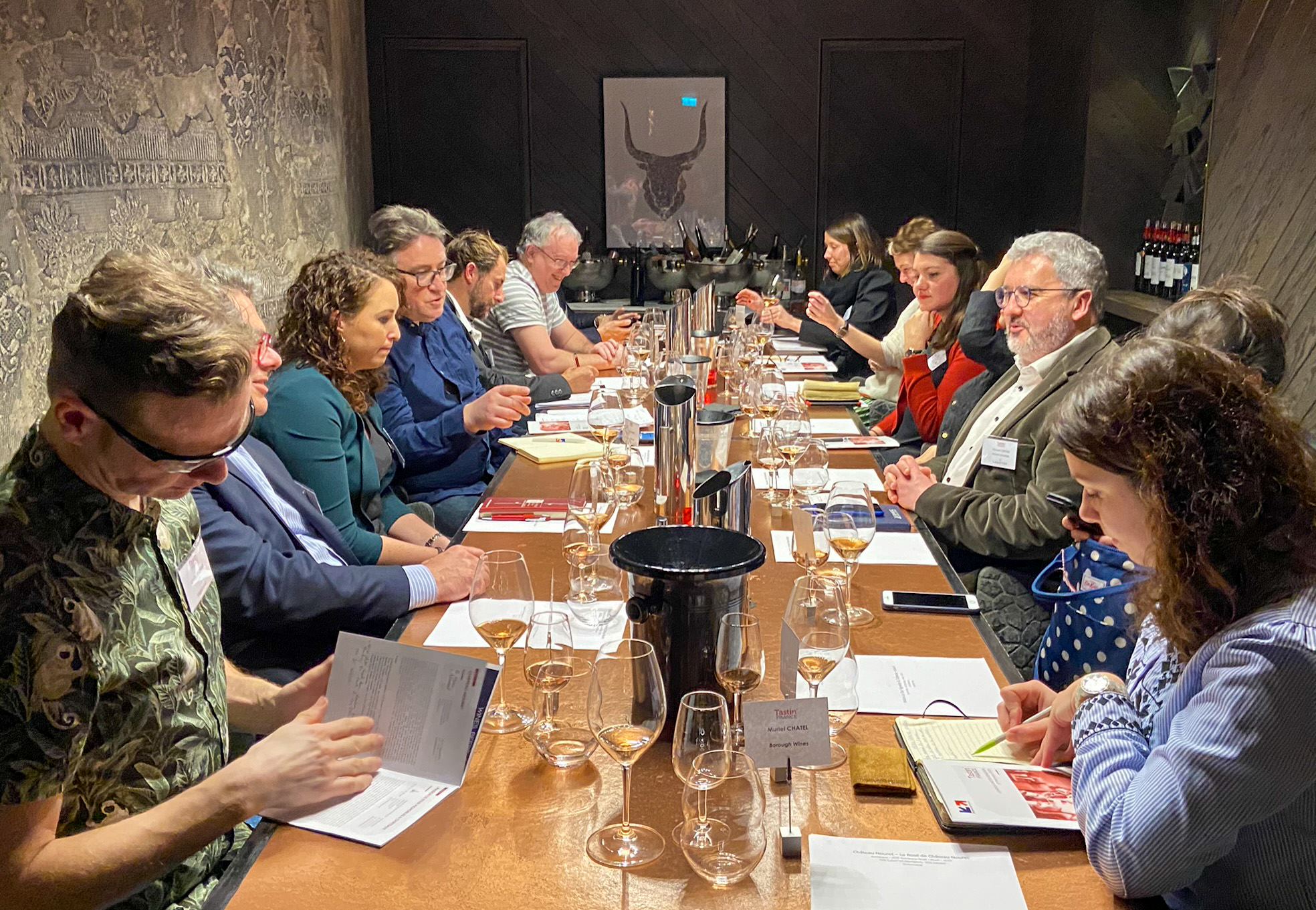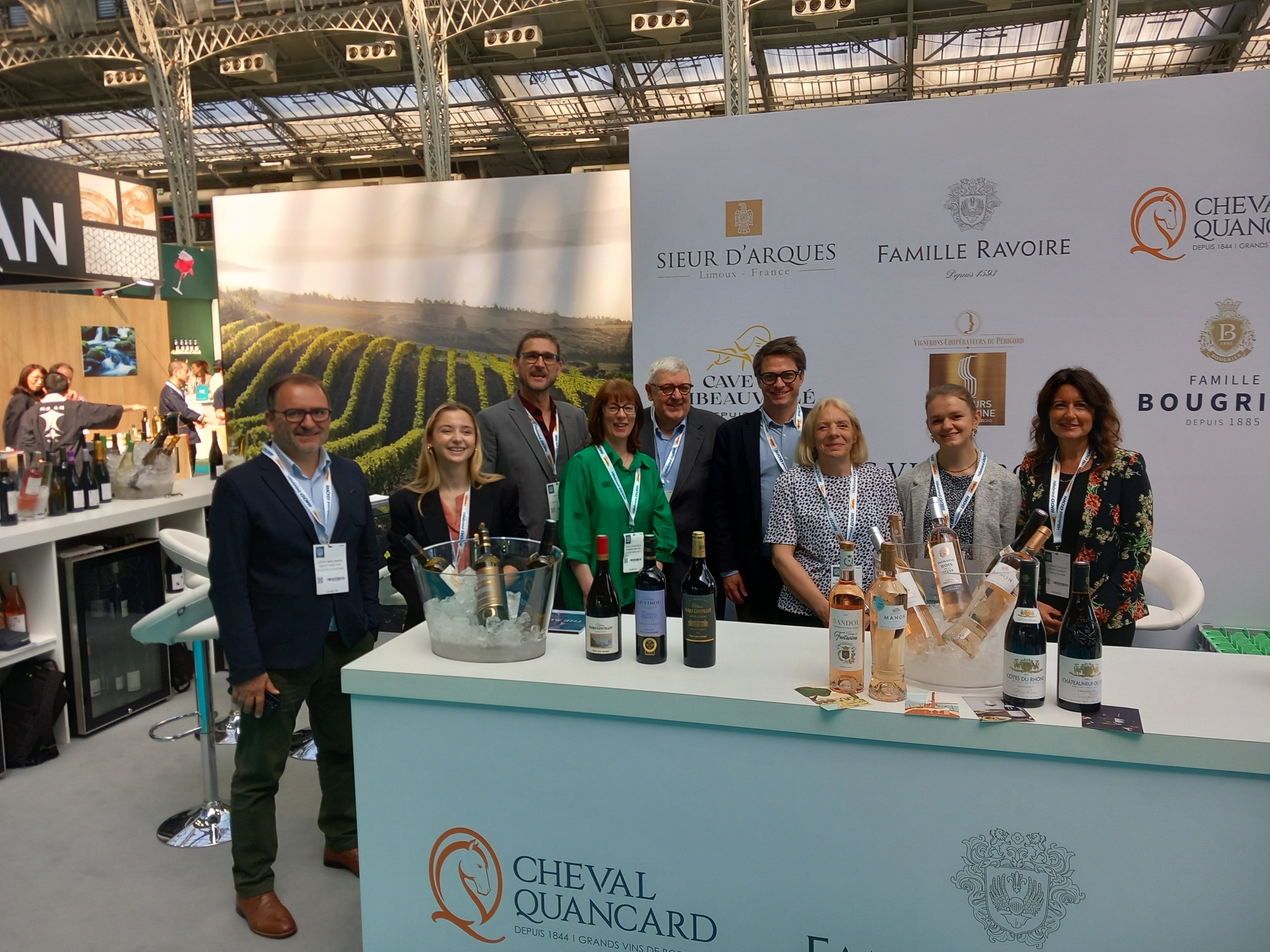The Buyer and Business France Rosé Debate gave producers and UK buyers alike the opportunity to share their insights into how the French rosé category can grow in the future.
For decades rosé wines have sat on supermarket shelves, on wine lists and on the back bar of bars and pubs, largely unloved by the great wine buying public. Yes, there were those who have always thought that pink was best, but for the vast majority of consumers it was always white and red wines that came first.
But as consumers have increasingly looked to seek out ever lighter, and even more refreshing, and lower alcohol wines to drink then rosé’s time in the spotlight has finally come.
(Here’s a video taking a behind the scenes look at how the day went)
Rosé wines, for example, now make up 10% of all wines sold in the UK off-trade (IRI to Dec 2019), up from 8% in 2002, and whilst they are still way behind the share for whites (48%) and reds (42%) they have become a must have rather than a nice to have on any wine list.
Not only has rosé helped bring more people into the category, looking for that refreshing drink at the end of the day, it has also brought a more ambitious consumer with CGA reporting that 50% of rosé drinkers are more likely to want to trade up when drinking in a bar in a restaurant.
It seems the stellar rise of rosé is now bringing other ‘pink’ alternatives into what could be seen as a separate pink alcohol category.
The challenge, therefore, for producers and buyers is to keep moving, adapting and bringing ever more interesting, premium and gastronomic rosés to the market.
Debate concept
That was very much the focus of The Buyer and Business France Rosé Debate. The idea for the debate was to not just bring buyers and producers together to look at the French rosé category, but to also to give buyers the chance to taste through a wide selection of examples of different styles of rosé being made across France. For whilst the dry Provence style has driven the rosé phenomenon there is a need for alternatives which other French regions can bring to the table…and the back bar.
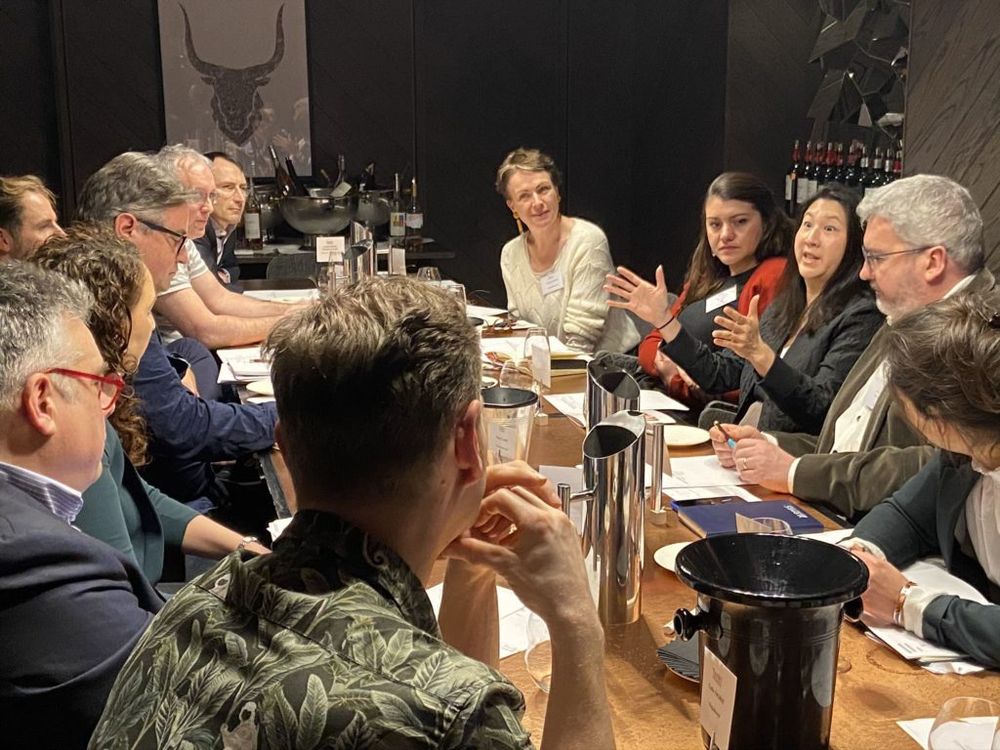
Graft Wine’s Miranda Fong said she was keen to see more rosés from different parts of France
Which means if buyers and producers are going to be able to meet all this new demand for rosé they are going to have to find more regions to work with. Which also means introducing consumers to potentially different styles of rosé made from an alternative combinations of blends, be it Cabernet driven or Merlot, rather than the largely Grenache and Cinsault blends behind the popular Provence-style wines.
Eight producers from across France showcased their wines and talked about what different regions can do. The eight producers and representatives taking part were:
The Producers and Regions
Bordeaux
Pierre-Clément Pène: Château Nouret
Christina Baker: Maison Le Star Vignobles & Châteaux
Marina Pascaud: Vignobles Bouillac
Antoine Michel: Vignobles Chevalier
Languedoc Roussillon
Laura Sicard: Dom Brial
South West
Vincent Creton: Maison Labastide
Provence
Aynard de Clermont: Commanderie de Peyrassol
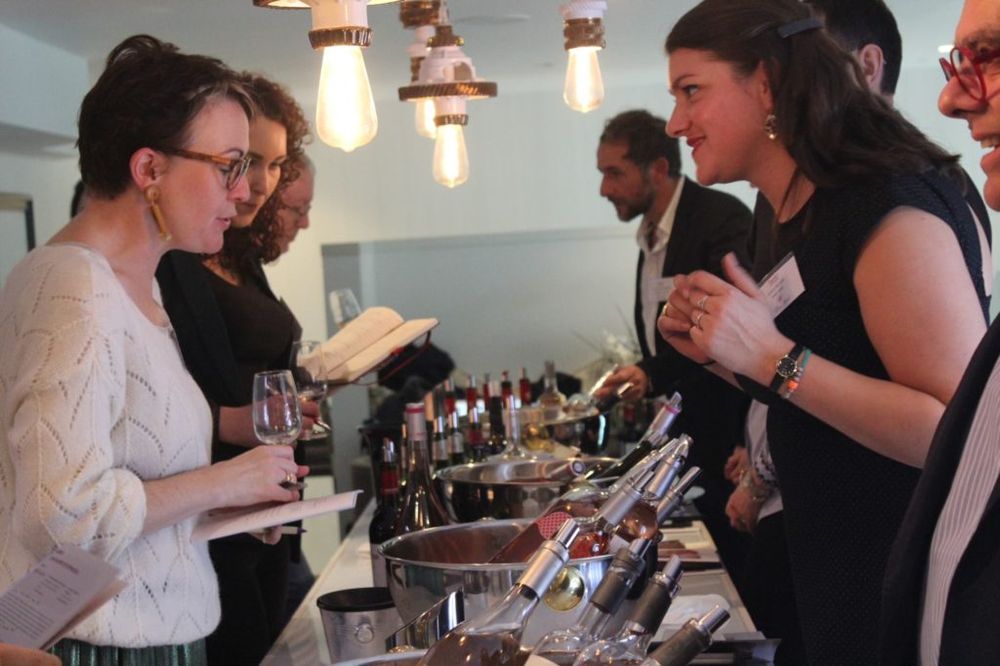
St John’s Victoria Sharples says French rosé is hugely significant to the group
The Buyers
From the buyers side a panel made of leading importers, wine merchants and wine bars came to share their insights on the UK market, and the kinds of wines they think have the best chance of success in the UK. The panel included:
Colin Thorne: Vagabond Wines
Victoria Sharples: St John Wine
Rebecca Gergely: Enotria & Coe
Doug Wregg: Les Caves de Pyrene
Miranda Fong: Graft Wine
Megan Clarke: Ellis Wines
A leading category
So where does rosé, and French rosé in particular, sit in terms of importance within their overall wine buying?

Vagabond has a dedicated machine just for rosé wines says Colin Vagabond. The category is now critical for its overall performance
It’s paramount to Colin Thorne, wine buyer at Vagabond Wines, which now has eight wine bars across London, including its own urban winery. With a trading model that relies on having 100 by the glass wine machine in its bars, that means there are 10 slots up for grabs at any one time for rosé. A buying task he does not take lightly.
“Rosé is probably the most important tasting I do every year,” he said. “It’s the area where we probably import the most compared to any other section. Which is quite extraordinary to me. Rosé makes people come and enjoy themselves with us and helps us make money.”
In fact it has become such an important part of Vagabond’s business that at its site in Victoria, London, it now has a dedicated machine just to different styles of rosé which has made a huge difference to sales, he said.
Megan Clarke, wine buyer at Ellis Wines, agreed French rosé was key to the success of the overall performance of France, which is such an important category for the business. Particularly now that rosé is being bought and drunk all year round. “Our Christmas sales of rosé were the biggest they have ever been,” she added.
Which has opened the way for Ellis to look far more to work with producers to make their own house rosé blends.
Miranda Fong, wine buyer at Graft Wine, last summer’s merger behind Red Squirrel Wine and Knotted Vine, said France is the biggest part of its business, so it’s vital she gets her rosé buying right.
Rebecca Gergely at Enotria&Coe said she felt the time was right for France to show more what its regions can do and if it can do that the “market will be very receptive”. “People are looking for something a little more sophisticated,” she added. “We are prepared to sell different rosés from all over France and target the right people with them.”
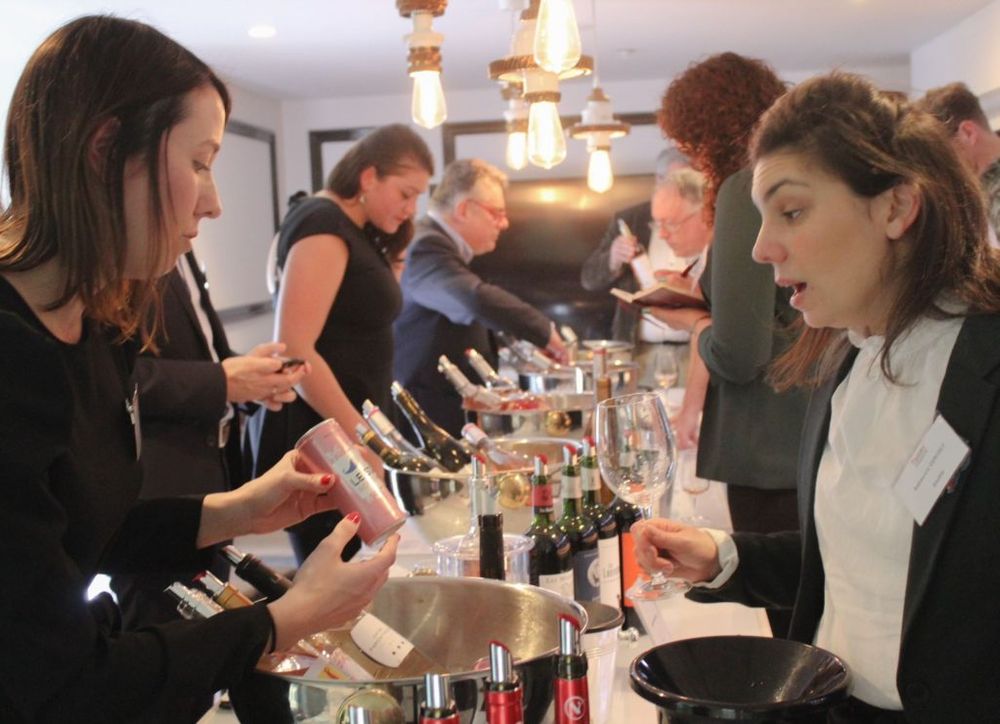
Christina Baker at Maison Le Star Vignobles & Châteaux in Bordeaux shows Enotria’s Rebecca Gergely what it is doing in cans
All year round sales
Victoria Sharples, who heads up wine buying at St John Wine, and is responsible for buying wine for the restaurants, but also its wholesale customers, only buys and lists French wine. So French rosé is of huge significance to the group, she said. Be it going direct to producers to list their wine, or working with growers and winemakers to blend wines of their own.
“I am a huge supporter of French rosé all year round. We now have 10 rosés and sometimes people will ask me why we have so many, but there are so many different styles throughout France, whether it is a Sancerre, or from the Languedoc. Our chefs drink rosé. This is their preferred drink which says a lot.”
The fact the demand keeps coming then gives her the confidence to try different styles, but also formats like bag in the box rosé and also its own St John Rosé that it also exports. “It’s running out of the door,” she said.
A no brainer…
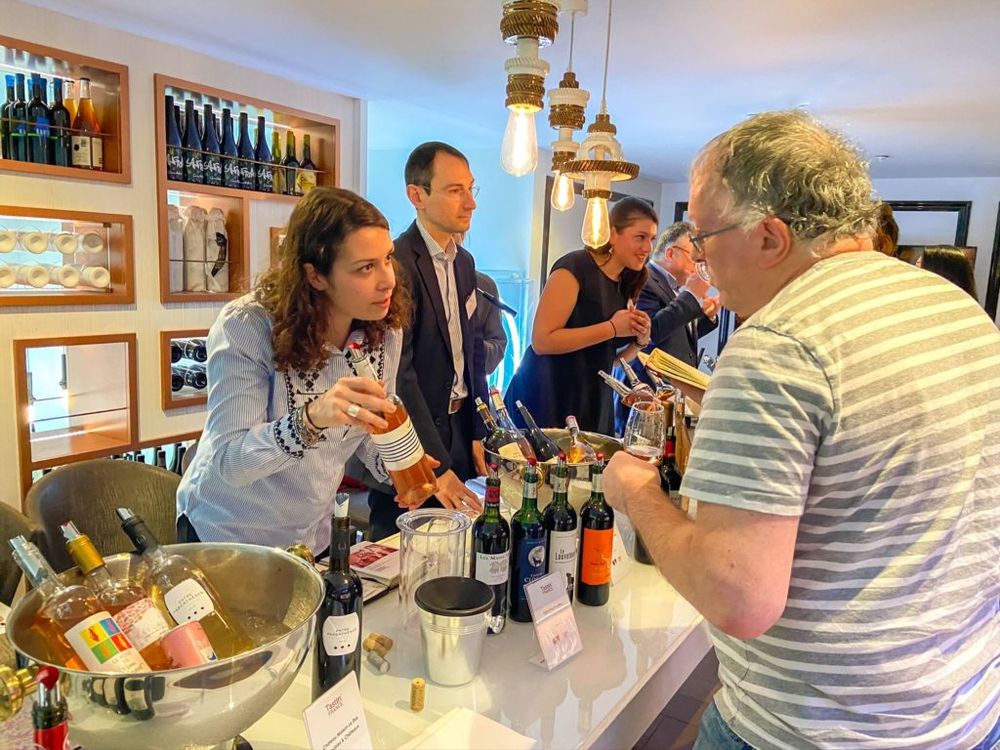
Doug Wregg as Les Caves de Pyrene has been championing French rosé for years
French rosé has been an important part of Les Cave de Pryene for some time, said Doug Wregg, whose focus is very much on seeking out biodynamic and natural rosé wines. “I identified rosé as becoming a big thing quite a long time ago. We now sell around 300,000 bottles of rosé a year. The vast majority of which comes from the Languedoc and Provence.”
“It’s a successful, no brainer option for us and we have about 25 rosés on our list.”
In fact in the summer of 2018, when we hit peak rosé, sales of Les Caves de Pyrene’s 25 rosés out sold all the hundreds of white wines it had on its list. “That’s amazing to think.” He agreed with the rest of the panel that the rosé season is fast becoming all year round, but it does sell “obscene amounts” from spring to early autumn. Which is where he sees the bulk of the opportunity for French rosé as winter sales tend to switch to more “structured rosés” and the New World.
Its all year round appeal is another reason why rosé has moved up the agenda of importance for importers, stressed Gergely.
The rise of (pale) rosé
We might all now be clambering over one another to drink pale rosés that was not the case when Wregg first started importing French rosé. Then it was more likely to be the darker styles that restaurants were listing.
Les Cave’s own history with French rosé very much mirrors the wider trends that have happened as it looked to champion and also source greater quality paler styles from Provence, added Wregg. “We became strong in Provence and people liked the paler, more restrained styles that we were majoring on.”
But the big change now, said Wregg, is the willingness for restaurants to have not just the one rosé that they used to allow, but to now list three and then up to five or six in the summer.
Gergely said it is the paler styles that are driving the big volumes of rosé, and is really the gift that keeps on giving for major distributors.

Aynard de Clermont of Provence rosé producer, Commanderie de Peyrossel, says it is vital producers work hard to raise standards of rosé
Aynard de Clermont of Provence rosé producer, Commanderie de Peyrossel, said the demand for paler rosés is only going to get stronger now that the US market has really caught on. “The US market is asking for dry rosé and that is the market for France to go after,” he said.
Laura Sicard of Dom Brial. She said the winery which has its “feet in the Mediterranean and its head in Provence” such are the coastal and altitude influences on this estate close to Perpignan in the heart of the Languedoc Roussillon, has really focused in on rosé, and paler rosés over the last 15 years. Rosé now accounts for a quarter of its production.
“Provence is leading the rest of France in terms of colour,” she said. “We are producing pale rosé in direct response to the demands from the market,” she said.
Now it works with its 200 growers, across nearly 2,000 hectares, over five distinct terroirs, to be able to offer a wider range of rosé, but it’s the pale styles that are the order of the day.
Bordeaux’s opportunity
It was interesting, for example, to see the Bordeaux producers also promoting paler styles rather than the darker ‘clairet’ style that Bordeaux is famous for. But that is what the market wants, stressed Christina Baker at Maison Le Star Vignobles & Châteaux in Bordeaux.
“Bordeaux relies a lot on our export markets and what people are looking for from China and the US in particular. So there is more and more opportunity for us with rosé in both our domestic and export markets,” she said.
Vignobles Bouillac, in Blaye-Côtes de Bordeaux, which is also a nursery of Grand Cru Classé wines and specialises in Malbec and Petit Verdot, had previously, over its three generations of winemaking, been famous for making red wines. But with demand for rosé growing all the time it too has started making its own “fruity” style, says Marina Pascaud. “We believe the opportunity is there for us to make rosé, but not white wines.”

The tasting was a chance for all the producers to show their wines to each of the buyers
It relies a lot on the skill of the winemaker to move away from the traditional darker Bordeaux rosé styles, said Pierre-Clément Pène at Château Nouret.
The rise of rosé has certainly come at a good time for Château Nouret, that has 14 hectares of vineyards in Valeyrac in the north of Médoc, Bordeaux, that was only formed in 2012 and first started making wine, and its inaugural rosé in 2018.
Pierre says they have deliberately made an unusual rosé wine out of Bordeaux in that it is 90% Cabernet, 10% Merlot, rather than the normal which is to have a wine dominated by Merlot. “We wanted to make a drier style,” he explained.
Point of difference
It was interesting to hear Baker say that it was increasingly important for Bordeaux producers to get away from comparing their wines to Provence and to push their own styles more, considering how much of the rest of the world looks up to and wants to follow what Bordeaux does. It seems in rosé even Bordeaux has to respect what is happening in Provence.
Vincent Creton at Maison La Bastide agreed: “We can’t all have the same wine. We have to be different from Provence.”
Its rosé production has doubled in recent years and now accounts for 20% of the wines it now produces at Maison La Bastide, a co-operative of producers located in Gaillac near Toulouse in the Languedoc Roussillon. It focuses mainly on sparkling wines, or rather the unique light mousse such as Perlé that the wines in the Tarn area produce.
“We are increasing production of rosé all the time and could see that rosé share go up to 25%,” said Creton. He hopes the fact the Gaillac style offers a real alternative to Provence will help it stand out in the market. “It’s what you might call more of a semi-sparkling style, but it happens naturally in the cellar. It means we have a fresher style that we hope will appeal to consumers.”
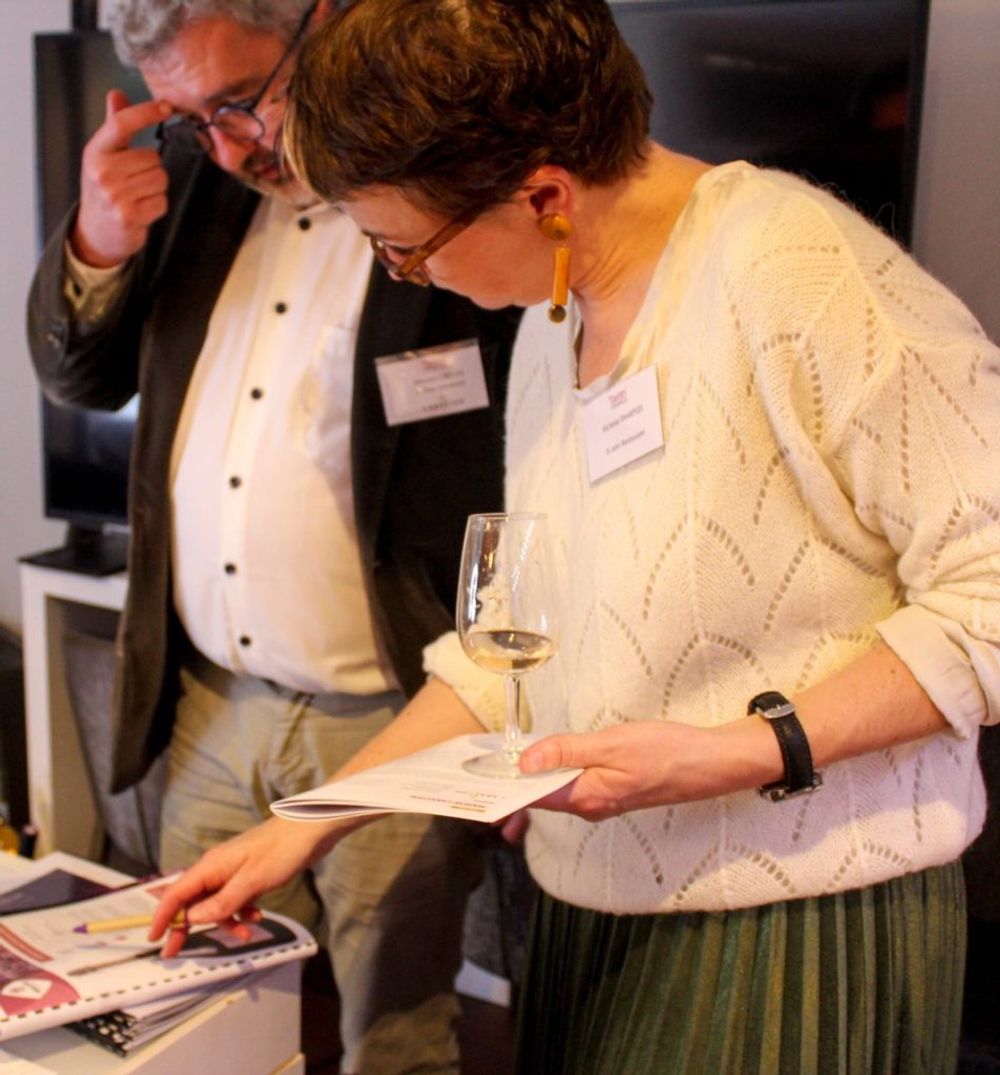
Victoria Sharples compares notes with Vincent Cretono of Maison Labastide
“We must, though, have a clear message that every region of France has a different style of rosé,” added Creton. “What it does do is help make a clean, fresh style of rosé that offers something different and reflects our own terroir,” he added.
Pushing diversity
Wregg said he is particularly keen on seeing how rosé wines evolve in the Loire where he thinks Cabernet Franc and Pinot Noir can really play a bigger part.
Thorne said that’s the challenge he sets himself when looking to source the wines for Vagabond’s dedicated 10 bottle rosé dispensing machine. “I get real joy in seeing the diversity you can get in just a list of 10 wines,” he said.
Wregg said he would welcome far more experimentation. “Does rosé need to come from red grapes. Why not make rosé say from Pinot Gris? It has phenolics it tastes more like a red wine than a rosé.”
Thorne said he would like to see more pet nat styles of rosé. It is even making its own English rosé wine with a Pinot Noir blend.
“We have to see more diversity in the category,” stressed Thorne. “It can’t all just be pale. We need to see more subtlety.”
Clarke at Ellis Wines believed the rosé market was now mature enough for consumers to start demanding more of that diversity on shelf and on restaurant lists. “That’s where the real opportunity is. People are interested in seeing more indigenous varieties in rosé. More organic and biodynamic options as well.”
Rosé also has the opportunity to tap into the trends around veganism and low-alcohol as well, said Sharples. “Where we can hand sell rosé then there are real opportunities to take to the consumer,” she added.
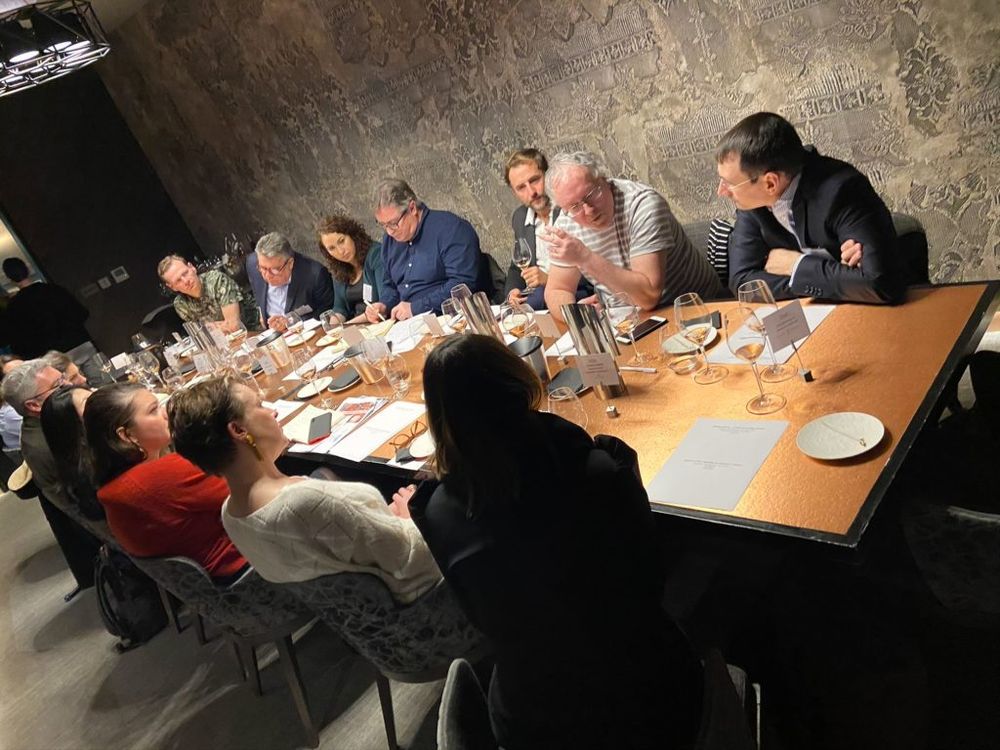
Doug Wregg says he would love to see how rosé can truly develop in more French regions
Pricing strategy
It’s why Enotria now has a clear pricing pyramid for the rosés on its list, explained Gergely, with a clear reason why each step and different rosé on the list was at that price point.
It all comes back, added Fong, to working closely with restaurant and sommelier teams so that they too can buy into the excitement and diversity that is possible within rosé. “It’s how the sommelier talks about rosé to their customer that is key,” she added. “Consumers then become more comfortable about trying different tastes.”
Regional rosé
The opportunity is also clearly there for each of the major regions in France to also stamp their own mark on the styles of rosé being produced.
It will be a process for producers to work through, said Laura Sicard at Dom Brial, as they work with their own regulations in their regions to see what styles of rosé work best for them. But she could see Tavel in the southern Rhône and the Loire as two examples of regions becoming known for their distinctive styles.
Megan Clarke at Ellis Wines said there “was a risk of it all becoming the same” and that buyers were keen to see alternatives from all over France. She agreed that “Tavel is very different”.
“There is something to be said for finding a point of difference that can help you stand out,” she said.
“But Provence rosé has been marketed so well that people’s perception of rosé is that it is pale. It has given them the confidence to try and buy it. If they now see a darker rosé they don’t know what it means or will taste like.”
She added: “We need to focus more on what consumers want and find ways to introduce more aged rosés and darker wines to them.”
Rebecca Gergely at Enotria & Coe agreed: “Within Provence itself there are different shades and styles to choose from.”
Sharples at St John said the Languedoc was already ideally placed to take some of the slack from Provence. “It’s still the south of France and it is still making pale rosé,” she said.
“Also Provence is more expensive and Languedoc is cheaper. There is a danger of people only buying on price, so we need to see more rosés with that varietal character where it can become really interesting.”
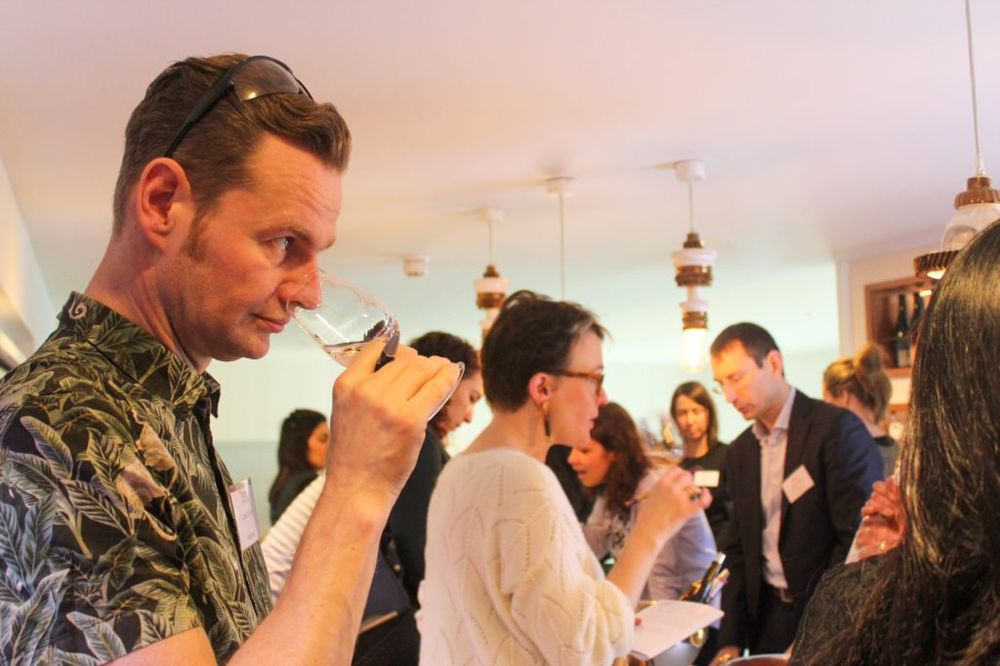
Colin Thorne says he has 10 key slots to buy for each year for rosé
Greater respect
Rosé was also becoming far more respected by winemakers and the wine community within France, said Antoine Michel at Vignobles Chevalier, the family owned and run by Erin and Richard Chevalier, which now runs four estates across four appellations in Bordeaux. Although its rosé production is from just two hectares and only makes up 5% of what it does, it’s also the hardest wine to make, said Antoine Michel.
“Rosé wine has for a long time not had the respect it deserves, but that has changed over the last five years in France,” he added. It’s also why it’s very much committed to making a quality, premium 100% Cabernet Franc rosé style that can be the signature of the winery, he added.
Baker at Maison Le Star Vignobles & Châteaux agreed there has been real sea of change in France over the last five years about rosé.
“Every winemaker really cares about the rosé wines they are making,” added Laura Sicard of Dom Brial. “It’s their challenge every year.”
- In Part Two of our report on the French Rosé Debate we will take a closer look at what price points are working best for rosé in the on-trade, the pressure on producers to continue to raise standards and how more gastronomic and aged rosés have such potential.
- Thanks to the team at M Victoria for their help in putting on the tasting and hosting the debate.
Business France
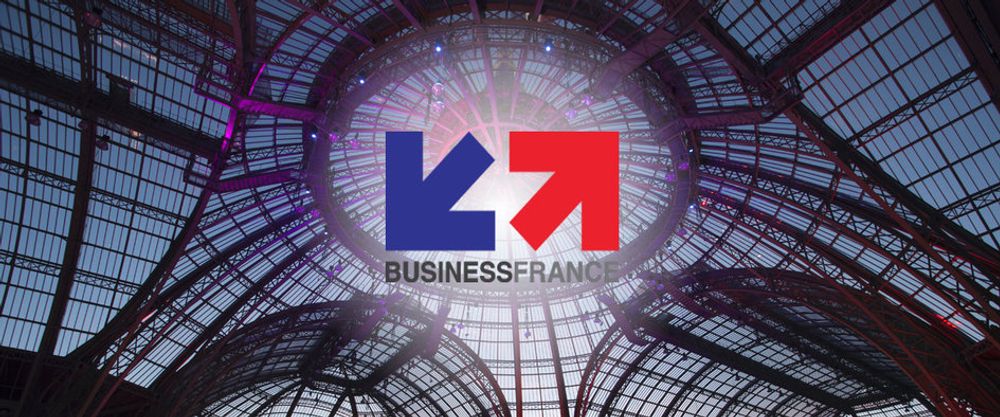
As a French agency Business France promotes French businesses into the UK and British investment into France.
Business France organises over 30 tastings all around the world in more than 60 cities.
This year in partnership with The Buyer our tasting/debates are focusing on rosé, sparkling and organic wines from France. If you would like to attend either of these events then please email Richard Siddle on richardsiddle@btopenworld.com.
May 5: How organic can you go ?
June 3: Sparkling Wines
Other professional tastings organised by Business France include:
March 12: En Primeur Bordeaux Le Grand Cercle des Vins de Bordeaux – Le Méridien Piccadilly, 4pm-9pm
April 6: Biodyvin – Oxo Tower. 10pm-5.30pm
June 19 & June 30: French Stand at Imbibe Live Olympia.
To register your interest, please contact Pandora.mistry@businessfrance.fr
